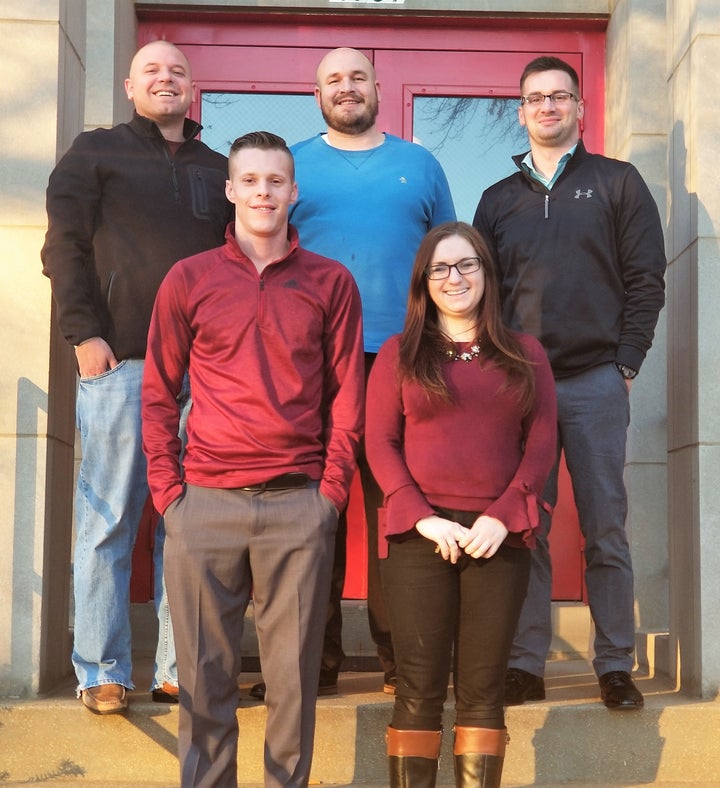
Back: L to R John Stuckey, Michael Phelps, Jordan Hampton Front: L to R Colton Baker, Samantha Corwin
John Stuckey is 33 years old. This will be the fifth Christmas he’ll celebrate without waking up, immediately hustling for a bag of heroin, setting up his needle and spoon and injecting bubbling heroin into his arms. Mind you, not to get high, but just to feel normal and be able to celebrate Christmas Day with his family.
Samantha Corwin (aka Sam) is a mere 22 years young. She is zeroing in on her first Christmas clean. Last year, she was living in Nashville in a physical and emotionally abusive relationship. That Christmas, Samantha called her parents in St. Louis and asked to come home for the holidays. They flew Samantha home, and she lasted two days before she fled and returned to Nashville to mental abuse, fists, and heroin.
Jordan Hampton (aka Picasso), 26, a star football player in high school has been in and out of psychiatric hospitals, detox programs and even spent two weeks in the faith-based, Teen Challenge. Jordan has 15 months clean and is about to celebrate his second Christmas with an overwhelming feeling of self-worth.
Michael Phelps, 33, a former auto mechanic manager that earned over 100,000 a year will be two months short of celebrating his 2nd Christmas without a needle in his arm. Before that, Michael spent Christmas day with his drug family at his drug dealers home.
Colton Baker (aka T1000) is 27-years-old. He is three years clean and sober. This Christmas day he will celebrate by answering overdose calls from all the local St. Louis, Missouri area hospitals. He’ll jump in his car, likely reflect on where he was on Christmas Day before recovery and head into the hospital to share his experiences in an attempt to save a life of an individual that almost succumbed to opioids.
How did five heroin addicts from St. Louis, Missouri do it? How are they celebrating Christmas heroin free?
What if I told you that their answer and maybe even the answer to crushing the worst health crisis in America’s history could be a drug that has been sitting on the shelves of pharmacies across America for more than 30 years?
What if I told you that the reason it sits on the shelf is that Big Pharma, their lobbyist, and political hacks in the United States Government are raking in millions of dollars a year by keeping it on the shelves?
Impossible, right?
Let me explain. Currently, only three drugs are being used to treat the rapidly growing population of opioid addicts. Two of them, Suboxone and methadone are opioid agonists and the third; naltrexone is an opioid antagonist.
In other words, two-thirds of what is called, MAT (medically assisted treatment) for opioid addicts is a powerful opioid. Let me say that again, two out of three drugs used as harm reduction to curb the spread of disease, violent crime and death by overdose is a substitute opioid.
Every single morning in America, millions of opioid addicts stand in line to drink a daily dose of methadone. In fact, I kicked heroin in 1987 and a few people I ran with on the streets of Lowell, Massachusetts are still in those lines.
Suboxone called the “wonderful failure,” is administered by less than 4% of US physicians. Doctors willing to prescribe Suboxone must first obtain a DEA waiver to administer the powerful opioid agonist. To be granted a waiver, each physician must pass an 8-hour test. The first year of prescribing, the doctors can have only 30 patients on Suboxone. After twelve months, they can apply to the DEA and increase the patient numbers to 100.
Let me regress. The BINGO term being tossed around by academics, self-proclaimed experts and the politician running this heroin epidemic is HARM REDUCTION. It is a catchy buzz-word that carries extraordinary resolve by many individuals who have never spent a second working directly with heroin addicts or for that matter, never experience the mental tenacity it takes to live chasing a drug that threatens your very survival.
But to cut to the chase, harm reduction gives the addict a chance to live another day. Albeit, a day whereas the addict is removed from harming themselves or society and administered another opioid, either Suboxone or methadone.
To be clear, I am a leading advocate for allowing all of my fellow brother and sister heroin addicts another day of life. A day without stealing their family’s snow blower out of the garage while their children sleep quietly in a bedroom above them. A day without selling their bodies on the street for 20 dollars. A day without robbing a gas station with a toy gun and potentially facing 5 to 7 in the state penitentiary.
But we must do better than administering opioids to opioid addicts as the End Game. Do we treat alcoholics with a daily dose of alcohol?
Percy Menzies, President of Assisted Recovery Centers of America know around St. Louis, Missouri as ARCA, is a pioneer in the battle to end the opioid crisis. Percy sounded the alarm of the dangers confronting America years before the death numbers turned the accidental overdose of opioids into the leading cause of death for Americans under 50.
Menzies says, “Methadone and Suboxone is the most profitable business in medicine. There are no accounts receivable. There are no co-pays. You stand in line and pay cash.”
Naltrexone is not an opioid. Naltrexone is not addictive.
“I don’t understand it. Naltrexone is the same drug as Narcan, the drug almost every policeman and fireman in America carry while they are on duty. Narcan saves lives immediately,” Menzies explains. “Why aren’t we using this drug? The only difference between Narcan and Naltrexone is the length of time the drugs works. Narcan is short lasting and Vivitrol, the injectable form of naltrexone, last thirty days.”
Now let me jump back to my five recovering addicts in St. Louis and the question I presented previously. How did they do it? First, let me preface by stating that I completely understand that my interview was limited to five white middle-class young adults from Missouri in a conference room for four hours.
However, as Rachel Winograd, Ph.D., the Assistant Research Professor at the University of Missouri - St. Louis, who oversees the 20 million dollars, the federal government allotted Missouri to combat the opioid crisis said, “In Missouri, White individuals account for most of Missouri’s opioid deaths. In fact, 1 in every 5 overdose deaths in Missouri is among Blacks or African Americans. But they only account for 1 in 10 of Missouri’s population. They are dying at twice the rate of White people.”
However, John Stuckey, now the President of ARCHway Institute, a nonprofit that provides scholarships for recovering addicts early essentials like food, clothing and shelter, Samantha Corwin, now overseeing a female Recovery House in St. Louis, and Michael Phelps, Jordan Hampton and Colton Baker, now working for EPICC, the Missouri initiative that immediately responds to opioid overdoses at St Louis area hospitals, all were introduced to naltrexone.
As Michael stated, “Naltrexone has given us all access to a quality life.”
Each one of them did the “Suboxone shuffle” whereas they would visit the Suboxone Doctor twice a month, pay an average of 390 dollars cash for a sheet of Suboxone and another 250 cash dollars for each visit. In fact, Michael and John told me they paid between 1250 to 1500 dollars cash every month to be treated with this highly addicted opioid.
But naltrexone became their drug of choice and naltrexone has given them the opportunity to celebrate Christmas day completely free of any opioid agonist that creates a conscious sedation and separation them from reality.
“Not too long ago, I celebrated Christmas in the Trump Towers down in Panama with my family dope-sick. Twenty minutes before our plane landed, I was emailing drug dealers,” Michael recalls.
“I remember the Christmas my parents took the whole family on a cruise,” John says, “I spent the entire time in my cabin deathly sick in a state of heroin withdrawal.”
The holidays are an extremely stressful time for everybody in America. People running around in chaotic madness buying presents and last-minute stocking stuffers. For heroin addicts, Christmas brings a sense of hopelessness and despair. Or as Jordan AKA Picasso so wonderfully sums it up, “Christmas brings heroin addict to a state of homelessness.”
Now I would be a fool to think naltrexone is the only answer. We must hit this epidemic with every possible weapon in our arsenal. But the end game must lead opioid addicts to an access to a quality of life similar to John Stuckey, Michael Phelps, Jordan Hampton, Colton Baker and Samantha Corwin’s Christmas smiles.
Ritchie Farrell is the author of I Am A Heroin Addict.
Follow Ritchie Farrell Live Streaming TV Show I Am A Heroin Addict
Need help with substance abuse or mental health issues? In the U.S., call 800-662-HELP (4357) for the SAMHSA National Helpline.
